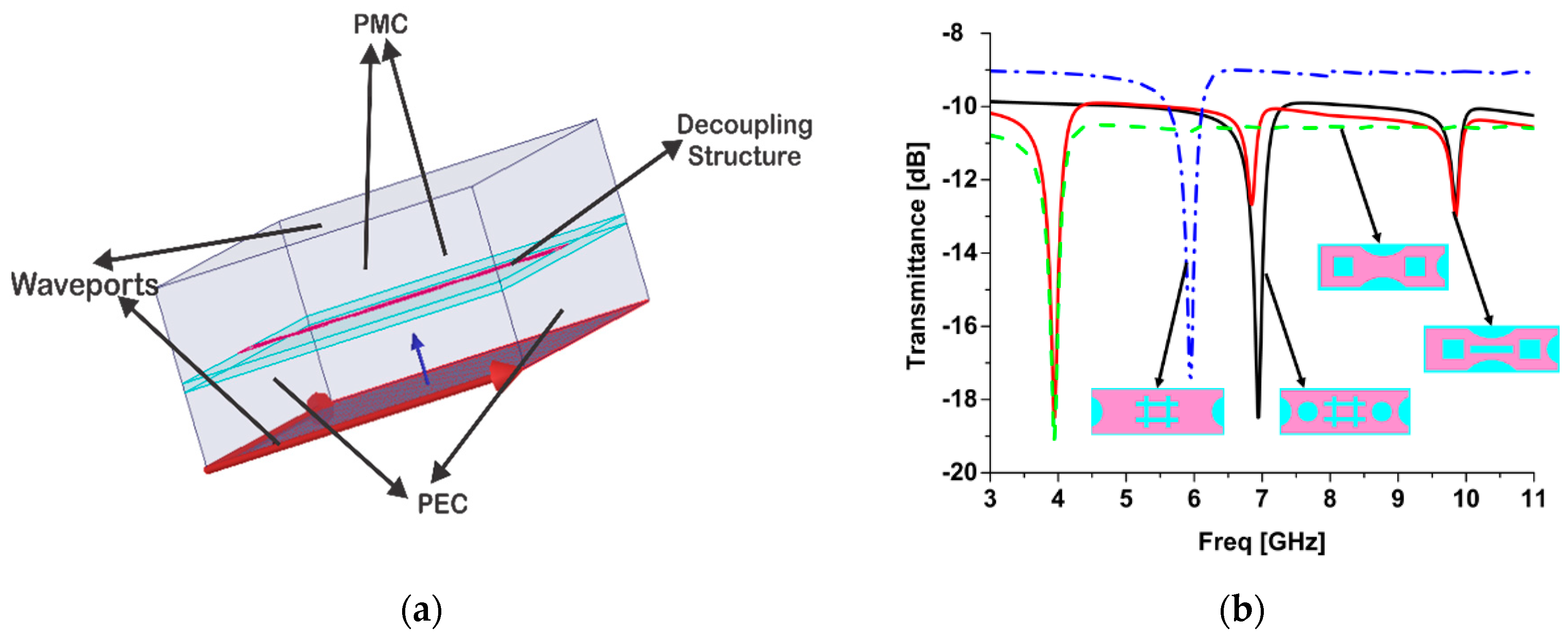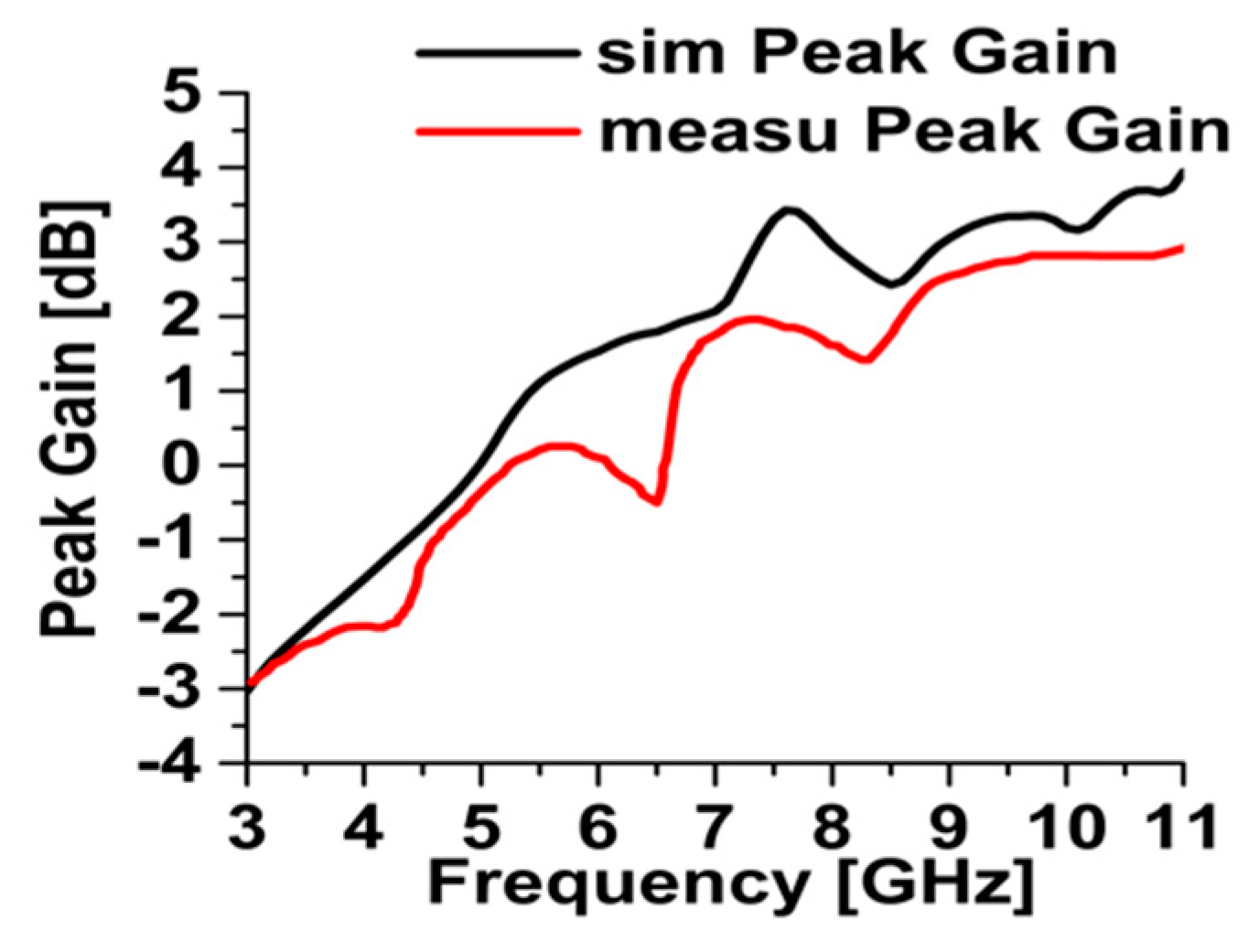A Compact Quad-Element UWB-MIMO Antenna System with Parasitic Decoupling Mechanism
Abstract
:1. Introduction
2. Antenna Configuration
2.1. Single UWB Antenna Configuration
2.2. UWB-MIMO Antenna Configuration
2.3. Equivalent Circuit Modeling
3. Isolation Mechanisms
3.1. Decoupling Structure for Side-by-Side Radiators
3.2. Decoupling Structure for Across Radiators
3.3. Analysis of Parasitic Decoupling Structure
4. Results and Discussions
4.1. Induced Surface Currents
4.2. Impedance Matching
4.3. Isolation/Decoupling Performance
4.4. MIMO Performance Parameters
4.5. Radiation Characteristics
5. Comparison with the Existing Literature
6. Conclusions
Author Contributions
Funding
Conflicts of Interest
References
- Roshna, T.K.; Deepak, U.; Sajitha, V.R.; Vasudevan, K.; Mohanan, P. A Compact UWB-MIMO Antenna with Reflector to Enhance Isolation. IEEE Trans. Antennas Propag. 2015, 63, 1873–1877. [Google Scholar] [CrossRef]
- Sipal, D.; Abegaonkar, M.P.; Koul, S.K. Easily Extendable Compact Planar UWB-MIMO Antenna Array. IEEE Antennas Wirel. Propag. Lett. 2017, 16, 2328–2331. [Google Scholar] [CrossRef]
- Chandel, R.; Gautam, A.K.; Rambabu, K. Tapered Fed Compact UWB-MIMO-Diversity Antenna with Dual Band-Notched Characteristics. IEEE Trans. Antennas Propag. 2018, 66, 1677–1684. [Google Scholar] [CrossRef]
- Nadeem, I.; Choi, D. Study on Mutual Coupling Reduction Technique for MIMO Antennas. IEEE Access 2019, 7, 563–586. [Google Scholar] [CrossRef]
- Iqbal, A.; Saraereh, O.A.; Ahmad, A.W.; Bashir, S. Mutual Coupling Reduction Using F-Shaped Stubs in UWB-MIMO Antenna. IEEE Access 2017, 6, 2755–2759. [Google Scholar] [CrossRef]
- Yin, Y.; Hong, J.; Luo, C.; Amin, M. A compact planar UWB-MIMO antenna using modified ground stub structure. IEICE Electron. Express 2017, 14, 20170883. [Google Scholar] [CrossRef]
- Ul Haq, M.A.; Koziel, S. Ground Plane Alterations for Design of High-Isolation Compact Wideband MIMO Antenna. IEEE Access 2018, 6, 48978–48983. [Google Scholar] [CrossRef]
- Zhang, S.; Pedersen, G.F. Mutual coupling reduction for UWB-MIMO antennas with a wideband neutralization line. IEEE Antennas Wirel. Propag. Lett. 2016, 15, 166–169. [Google Scholar] [CrossRef]
- Hassan, T.; Khan, M.U.; Attia, H.; Sharawi, M.S. An FSS Based Correlation Reduction Technique for MIMO Antennas. IEEE Trans. Antennas Propag. 2018, 66, 4900–4905. [Google Scholar] [CrossRef]
- Qamar, Z.; Riaz, L.; Chongcheawchamnan, M.; Khan, S.A.; Shafique, M.F. Slot combined complementary split ring resonators for mutual coupling suppression in microstrip phased arrays. IET Microw. Antennas Propag. 2014, 8, 1261–1267. [Google Scholar] [CrossRef]
- Wu, D.W.; Cheunng, S.W.; Li, Q.L.; Yuk, T.I. Decoupling using diamond shaped patterned ground resonator for small MIMO antennas. IET Microw. Antennas Propag. 2017, 11, 177–183. [Google Scholar] [CrossRef]
- Ghosh, T.; Ghosal, S.; Mitra, D.; Chaudhuri, S.R.B. Mutual Coupling Reduction Between Closely Placed Microstrip Patch Antenna Using Meander Line Resonator. Prog. Electromagn. Res. Lett. 2016, 59, 115–122. [Google Scholar] [CrossRef]
- Gogosh, N.; Shafique, M.F.; Saleem, R.; Usman, I.; Faiz, A.M. An UWB diversity antenna array with a novel H type decoupling structure. Microw. Opt. Technol. Lett. 2013, 55, 2715–2720. [Google Scholar] [CrossRef]
- Srivastava, G.; Mohan, A. Compact MIMO Slot Antenna for UWB Applications. IEEE Antennas Wirel. Propag. Lett. 2016, 15, 1057–1060. [Google Scholar] [CrossRef]
- Tang, Z.; Wu, X.; Zhan, J.; Hu, S.; Xi, Z.; Liu, Y. Compact UWB-MIMO Antenna with High Isolation and Triple Band-Notched Characteristics. IEEE Access 2019, 7, 19856–19865. [Google Scholar] [CrossRef]
- Tao, J.; Feng, Q. Compact Ultrawideband MIMO Antenna with Half- Slot Structure. IEEE Antennas Wirel. Propag. Lett. 2017, 16, 792–795. [Google Scholar] [CrossRef]
- Yadav, D.; Abegaonkar, M.P.; Koul, S.K.; Tiwari, V.N.; Bhatnagar, D. Two Element Band-Notched UWB-MIMO Antenna with High and Uniform Isolation. Prog. Electromagn. Res. 2018, 63, 119–129. [Google Scholar] [CrossRef]
- Mathur, R.; Dwari, S. Compact 4-Port MIMO/diversity antenna with low correlation for UWB application. Frequenz. 2018, 72, 429–435. [Google Scholar] [CrossRef]
- Wu, W.; Yuan, B.; Wu, A. A Quad-Element UWB-MIMO Antenna with Band-Notch and Reduced Mutual Coupling Based on EBG Structures. Int. J. Antennas Propag. 2018, 2018, 8490740. [Google Scholar] [CrossRef]
- Anitha, R.; Vinesh, P.V.; Prakash, K.C.; Mohanan, P.; Vasudevan, K. A compact quad element slotted ground wideband antenna for MIMO applications. IEEE Trans. Antennas Propag. 2016, 64, 4550–4553. [Google Scholar] [CrossRef]
- Ibrahim, A.A.; Abdalla, M.A.; Hu, Z. Design of a compact MIMO antenna with asymmetric coplanar strip-fed for UWB applications. Microw. Opt. Technol. Lett. 2017, 59, 31–36. [Google Scholar] [CrossRef]
- Hu, H.; Chen, F.; Chu, Q. A Wideband U-Shaped Slot Antenna and Its Application MIMO Terminals. IEEE Antennas Wirel. Propag. Lett. 2016, 15, 508–511. [Google Scholar] [CrossRef]
- Kang, L.; Li, H.; Wang, X.; Shi, X. Compact Offset Microstrip-Fed MIMO Antenna for Band-Notched UWB Applications. IEEE Antennas Wirel. Propag. Lett. 2015, 14, 1754–1757. [Google Scholar] [CrossRef]
- Choi, J.; Hwang, W.; You, C.; Jung, B.; Hong, W. Four-Element Reconfigurable Coupled Loop MIMO Antenna Featuring LTE Full-Band Operation for Metallic-Rimmed Smartphone. IEEE Trans. Antennas Propag. 2019, 67, 99–107. [Google Scholar] [CrossRef]
- Hussain, R.; Sharawi, M.S.; Shamim, A. An Integrated Four-Element Slot-Based MIMO and a UWB Sensing Antenna System for CR Platforms. IEEE Trans. Antennas Propag. 2018, 66, 978–983. [Google Scholar] [CrossRef]
- Malviya, L.; Panigrahi, R.; Kartikeyan, M.V. Four Element Planar MIMO Antenna Design for Long-Term Evolution Operation. IETE J. Res. 2018, 64, 367–373. [Google Scholar] [CrossRef]
- Ibrahim, A.A.; Machac, J.; Shubair, R.M. Compact UWB-MIMO antenna with pattern diversity and band rejection characteristics. Microw. Opt. Technol. Lett. 2017, 59, 1460–1464. [Google Scholar] [CrossRef]
- Khan, M.S.; Capobianco, A.D.; Asif, S.; Iftikhar, A.; Ijaz, B.; Braaten, B.D. Compact 4 × 4 UWB-MIMO antenna with WLAN band rejected operation. Electron. Lett. 2015, 51, 1048–1050. [Google Scholar] [CrossRef]
- Zhu, J.; Li, S.; Feng, B.; Deng, L.; Yin, S. Compact dual-polarized UWB quasi-self-complementary MIMO/diversity antenna with band-rejection capability. IEEE Antennas Wirel. Propag. Lett. 2016, 15, 905–908. [Google Scholar] [CrossRef]
- Jafri, S.I.; Saleem, R.; Shafique, M.F.; Brown, A.K. Compact reconfigurable multiple-input-multiple-output antenna for ultra-wideband applications. IET Microw. Antennas Propag. 2016, 10, 413–419. [Google Scholar] [CrossRef]












| Ref. No | Geometry | Ports | Size (mm3) | Isolation (dB) | TARC | ECC | CCL | Peak Gain | Efficiency (%) | Frequency Band (GHz) |
|---|---|---|---|---|---|---|---|---|---|---|
| [18] | Planar | 4 | 36 × 36 × 1.6 | 15 | - | <0.5 | - | 2.5–4 | 70 | 3.1–10.6 |
| [19] | Planar | 4 | 60 × 60 × 1.6 | 17.5 | - | <0.3 | <0.4 | 8 | 91.2 | 3–16.2 |
| [20] | Planar | 4 | 45 × 45 ×1.6 | 14 | - | <0.25 | - | 4 | 91 | 2.2–3.8/2.3–5.7/2.4, 5.1–5.8 |
| [21] | Planar | 2 | 26 × 60 × 1.6 | 15 | - | <0.01 | - | 3.5 | 80 | 3.1–10.6 |
| [22] | Planar | 2 | 66 × 52 × 1.5 | 15 | - | <0.02 | - | 1.8–4 | 66 | Lower UWB band |
| [23] | Planar | 2 | 38.5 × 38.5 × 1.6 | 15 | - | <0.02 | - | 1.4–3.6 | 75 | 3.1–10.6 |
| [24] | Planar | 2 | 70 × 150 × 1 | >10.5 | - | <0.5/<0.1 | - | - | 40/80 | 0.699–0.960/1.710–2.690 |
| [25] | Planar | 4 | 120 × 60 × 1.5 | 13 | −10 | <0.248 | - | 3.2 | 75 | 1.77–2.51 |
| [26] | Planar | 4 | 68 × 98 × 1.5 | 10 | - | <0.1 | - | 2.73 | 71 | 1.66–2.7 |
| [27] | Planar | 2 | 50 × 28 × 1.6 | 18 | - | <0.12 | <0.4 | - | - | 3.1–10.6 |
| [28] | Planar | 4 | 50 × 39.8 × 1.524 | 17 | - | - | - | 2.5–6 | - | 2.7–5.1/5.9–12 |
| [29] | Planar | 4 | 50 × 50 × 1 | 20 | - | <0.3 | - | - | - | 3.1–10.6 |
| This work | Planar | 4 | 40 × 43 ×1 | 20 | −8 | <0.2 | <0.3 | 4 | 92 | 3.1–10.6 |
© 2019 by the authors. Licensee MDPI, Basel, Switzerland. This article is an open access article distributed under the terms and conditions of the Creative Commons Attribution (CC BY) license (http://creativecommons.org/licenses/by/4.0/).
Share and Cite
Amin, F.; Saleem, R.; Shabbir, T.; Rehman, S.u.; Bilal, M.; Shafique, M.F. A Compact Quad-Element UWB-MIMO Antenna System with Parasitic Decoupling Mechanism. Appl. Sci. 2019, 9, 2371. https://doi.org/10.3390/app9112371
Amin F, Saleem R, Shabbir T, Rehman Su, Bilal M, Shafique MF. A Compact Quad-Element UWB-MIMO Antenna System with Parasitic Decoupling Mechanism. Applied Sciences. 2019; 9(11):2371. https://doi.org/10.3390/app9112371
Chicago/Turabian StyleAmin, Fatima, Rashid Saleem, Tayyab Shabbir, Sabih ur Rehman, Muhammad Bilal, and M. Farhan Shafique. 2019. "A Compact Quad-Element UWB-MIMO Antenna System with Parasitic Decoupling Mechanism" Applied Sciences 9, no. 11: 2371. https://doi.org/10.3390/app9112371
APA StyleAmin, F., Saleem, R., Shabbir, T., Rehman, S. u., Bilal, M., & Shafique, M. F. (2019). A Compact Quad-Element UWB-MIMO Antenna System with Parasitic Decoupling Mechanism. Applied Sciences, 9(11), 2371. https://doi.org/10.3390/app9112371






